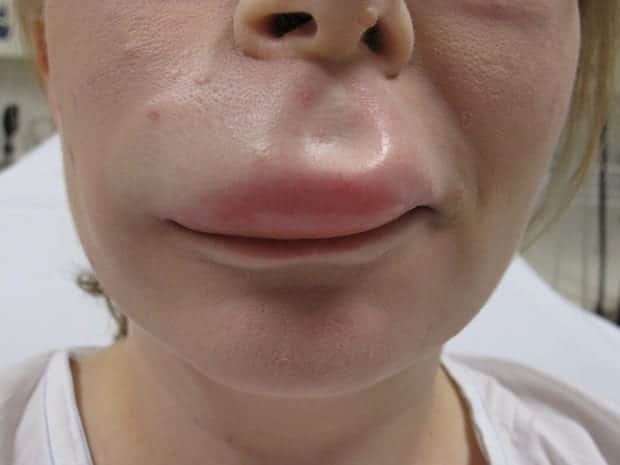Traumatic Angioedema
aka Immunological Inquisition 001
A 33 year old caucasian female presented to the emergency department following minor trauma to her upper lip. She sustained the injury whilst bending down to pick up a bag and struck her right upper lip against a metal pole. Although initially painful, there was no sign of external trauma, laceration or ecchymosis.
Shortly following the trauma she noticed that the lip was markedly swollen, spreading from the right side of the lip to involve the whole of her upper lip. Over the subsequent 2 hours the swelling increased and extended to the right cheek and submental region despite conservative management with ice and pressure.
She denied any recent insect bites; consumption of food precipitants (bananas, shrimp, peas, grapes, etc); illicit drug use; herbal medications; and food or drug allergies. She is not an atopic individual and has never suffered from hives, urticaria or angioedema previously.
Her past medical history included rheumatoid arthritis [controlled with methotrexate and a reducing course of steroids] and well controlled hypertension [treated with captopril (ACEI)]
Physical examination:
Physical examination was unremarkable with no evidence of respiratory compromise [HR 70, BP 115/64, RR 14, sO2 98% temp 97.4F]. Her oropharynx was clear and revealed no edema of the tongue or soft palate and there were no tonsillar exudates or ulcerations. Her lungs were clear to auscultation and without wheezing or stridor. She did not have a rash or any other signs of systemic allergic reaction.
There was marked tense oedema of the upper lip extending to the lower portion of the nose and obliterating the contour of the nasolabial fold on the right and extending to the right maxilla. The lower lip was normal in appearance.
Investigations:
- White blood cell count with differential and sedimentation rate were normal. Urine pregnancy test was negative.
Management:
- The patient was treated with 0.5mL [1:1000] adrenaline IM and 50mg prednisolone PO
- Her captopril was discontinued and she was admitted to the medical ward for observation and monitoring
- The swelling subsided within 36 hours and she was discharged home with BP 126/75 following cessation of ACEi and commencement of beta-blockers
Differential Diagnosis
- Angioedema [Acquired or hereditary]
- Cold-Induced Urticaria [secondary to ice application following trauma]
Most likely diagonosis:
- Angioedema due to ACEi without airway compromise with direct local trauma as the inciting event.
- The local release of bradykinin from trauma, in combination with decreased bradykinin catabolism secondary to ACE inhibitor therapy, resulted in angioedema predominantly in the upper lip. The angioedema resolved with discontinuation of the ACE inhibitor.
The clinical picture of angioedema was first described by Dr Heinrich Quincke in 1882, hence the eponym Quincke’s oedema. Sir William Osler remarked in 1888 that some cases may have a hereditary basis and he coined the term ‘hereditary angioneurotic oedema’. The ‘neurosis’ component has subsequently been dropped [as has the ‘o’ in many countries].
Definition:
- Angioedema is defined as a subcutaneous extension of urticaria resulting in swelling of the deeper layers of the skin or submucosal tissues.
- It usually presents as episodic attacks of swelling of the face, lips, tongue and airways, although it may also involve visceral tissues.
- Bradykinin is the important mediator behind the symptoms of angioedema.
- Bradykinin is a potent vasodilator associated with vasopermeability and rapid accumulation of fluid in the interstitium. This is most obvious in the face, where the skin has relatively little supporting connective tissue, and oedema develops easily.
- Various mechanisms that interfere with bradykinin production or degradation can lead to angioedema.
- ACE inhibitors block angiotensin converting enzyme – the enzyme that among other actions, degrades bradykinin.
- In hereditary angioedema, bradykinin formation is caused by continuous activation of the complement system due to a deficiency in one of its prime inhibitors, C1-esterase inhibitor, and continuous production of kallikrein
Epidemiology:
- Angiotensin-converting enzyme (ACE) inhibitormedications
- The incidence is more common in black Americans than in white Americans, in women than in men, and in smokers than in nonsmokers.
- Up to 25% of reported cases of angioedema seem to be a result of ACE inhibitor therapy [Reference]
- Incidence variably reported from 0.1-0.7% [Reference]
- Angioedema resulting secondary to ACE inhibitor use may occur many years after therapy has been initiated.
- Defective degradation of vasoactive peptide substrates of ACE, such as bradykinin or substance P, may contribute via non-ACE pathways to the pathogenesis of ACE inhibitor-associated angioedema
References
- Byrd JB, Adam A, Brown NJ. Angiotensin-converting enzyme inhibitor-associated angioedema. Immunol Allergy Clin N Am 2006;26:725–37 [Reference]
- Vleeming W, van Amsterdam JGC, Stricker BHC, deWildt DJ. ACE inhibitor-induced angioedema. Drug Saf 1998;18:171– 88 [Reference]
- AllergyCases.org – [Reference] [ACEi Reference]
- Angioedema After Local Trauma: [Reference]

CLINICAL CASES
Immunological Inquisition



